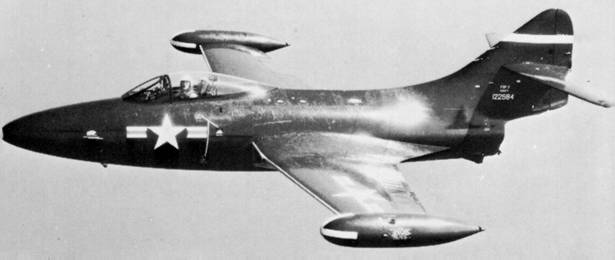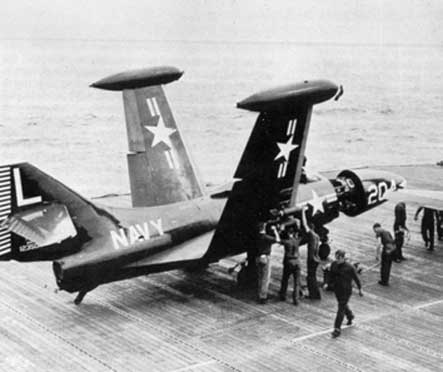

|
The Grumman Aircraft Company was some what late in the design and construction of a jet powered aircraft, this was due to the high priority work on the conventional powered XF8F "Bearcat" for the US Navy, however a number of design studies were done from June 1943 onwards,the most interesting of which was a development of the "Hellcat" fitted with a turbojet engine in the tail, however none of these ideas came to any thing. In September 1945 Grumman responded to a US Navy request for a two-seat radar equipped jet powered night fighter. The Grumman proposal was the G-75, looking very much like the F7F "Tigercat" and powered by 4x Westinghouse 24C-4B axial-flow turbojet engines mounted side by side in pairs under the wings, on the 11/4/1946 a contract was issued for two prototypes and given the designation of XF9F-1. But by late 1946 further studies had shown the G-75 would not meet the specification laded down by the Navy and the contract was all but canceled. |
|
In the mean time Grumman had been working on a new design for a single seat fighter/bomber the G-79, some how Grumman generated enough interest with the US Navy, that the contract for the XF9F-1 was amended on the 9/10/1946 to allow for the construction of 3x prototypes, 1x static airframe and a design study into a swept-wing version of the aircraft, which would end up as the F9F-6 "Cougar". A number of deferent engine layouts were proposed for the "Panther", such as 2x Westinghouse J-34 Axial-flow turbojets or 2x Rolls-Royce "Derwent" centrifugal engines mounted in the wing roots and exhausting under the rear of the fuselage, also under consideration a single Rolls-Royce "Nean" or Allison J-33 centrifugal turbojet engine, fitted in the fuselage and fed by two intakes ether side of the wing root. In the end the Navy specified the Rolls-Royce "Nean" to be built in the USA by Pratt & Whitney under license as the J-42. By the time the mockup was ready in early 1947 a number of changes had been made, such as the moving of the cockpit back wards and the exhaust being extended to the rear. The first prototype which was not fitted with any armament or ejector seat, started ground testing in October 1947, with the first flight being on the 21/11/1947 by test pilot Corwin.H.Meyer. |

|
|
During the flight trials it was found that the aircraft snaked at all speeds and was unstable longitudinally, also one of the test aircraft's tail section was ripped off when attempting an arrested landing, however once these problems were seen to, the F9F-2 "Panther" would prove to be a very sturdy aircraft indeed. The first production F9F-2 flew in August 1949, the only changes being the fitting of armament, a British Martin-Baker ejector seat and external wingtip fuel tanks (standard from the 13th production aircraft onward). It was first delivered to VF-51 at NAS San Diego on May 8, 1949, however because of initially-slow deliveries of the J-42 the aircraft were fitted with the Allison J-33 and designated as the F9F-3. The "Panther" was to remain in service until the mid-1960's. |